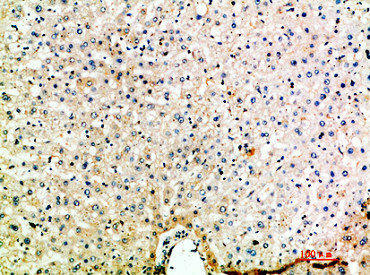Description
| Antibody Name: | CCL15 Antibody (PACO07380) |
| Antibody SKU: | PACO07380 |
| Size: | 50ug |
| Host Species: | Rabbit |
| Tested Applications: | ELISA, IHC |
| Recommended Dilutions: | ELISA:1:10000-1:20000, IHC-p:1:50-1:300 |
| Species Reactivity: | Human |
| Immunogen: | Synthetic peptide from human protein at AA range: 51-100 |
| Form: | Liquid |
| Storage Buffer: | PBS, pH 7.4, containing 0.02% sodium azide as Preservative and 50% Glycerol. |
| Purification Method: | The antibody was affinity-purified from rabbit serum by affinity-chromatography using specific immunogen. |
| Clonality: | Polyclonal |
| Isotype: | IgG |
| Conjugate: | Non-conjugated |
 | Immunohistochemical analysis of paraffin-embedded human-liver, antibody was diluted at 1:200. |
| Synonyms: | C-C motif chemokine 15 (Chemokine CC-2) (HCC-2) (Leukotactin-1) (LKN-1) (MIP-1 delta) (Macrophage inflammatory protein 5) (MIP-5) (Mrp-2b) (NCC-3) (Small-inducible cytokine A15) [Cleaved into: CCL15(22-92); CCL15(25-92); CCL15(29-92)] |
| UniProt Protein Function: | CCL15: Chemotactic factor that attracts T-cells and monocytes, but not neutrophils, eosinophils, or B-cells. Acts mainly via CC chemokine receptor CCR1. Also binds to CCR3. CCL15(22-92), CCL15(25-92) and CCL15(29-92) are more potent chemoattractants than the small-inducible cytokine A15. Belongs to the intercrine beta (chemokine CC) family. |
| UniProt Protein Details: | Protein type:Secreted; Motility/polarity/chemotaxis; Secreted, signal peptide Chromosomal Location of Human Ortholog: 17q12 Cellular Component: extracellular space Molecular Function:heparin binding; chemokine activity; receptor binding; chemoattractant activity Biological Process: cellular calcium ion homeostasis; positive chemotaxis; cell-cell signaling; immune response; chemotaxis; signal transduction |
| NCBI Summary: | This gene is located in a cluster of similar genes in the same region of chromosome 17. These genes encode CC cytokines, which are secreted proteins characterized by two adjacent cysteines. The product of this gene is chemotactic for T cells and monocytes, and acts through C-C chemokine receptor type 1 (CCR1). The proprotein is further processed into numerous smaller functional peptides. Naturally-occurring readthrough transcripts occur from this gene into the downstream gene, CCL14 (chemokine (C-C motif) ligand 14). [provided by RefSeq, Jan 2013] |
| UniProt Code: | Q16663 |
| NCBI GenInfo Identifier: | 3915594 |
| NCBI Gene ID: | 6359 |
| NCBI Accession: | Q16663.2 |
| UniProt Secondary Accession: | Q16663,Q9UM74, B2RU34, E1P651, |
| UniProt Related Accession: | Q16663 |
| Molecular Weight: | 12,248 Da |
| NCBI Full Name: | C-C motif chemokine 15 |
| NCBI Synonym Full Names: | chemokine (C-C motif) ligand 15 |
| NCBI Official Symbol: | CCL15 |
| NCBI Official Synonym Symbols: | LKN1; NCC3; SY15; HCC-2; LKN-1; MIP-5; NCC-3; SCYL3; MIP-1D; MRP-2B; SCYA15; HMRP-2B; MIP-1 delta |
| NCBI Protein Information: | C-C motif chemokine 15; leukotactin 1; chemokine CC-2; new CC chemokine 3; small-inducible cytokine A15; macrophage inflammatory protein 5; small inducible cytokine subfamily A (Cys-Cys), member 15 |
| UniProt Protein Name: | C-C motif chemokine 15 |
| UniProt Synonym Protein Names: | Chemokine CC-2; HCC-2; Leukotactin-1; LKN-1; MIP-1 delta; Macrophage inflammatory protein 5; MIP-5; Mrp-2b; NCC-3; Small-inducible cytokine A15Cleaved into the following 3 chains:CCL15(22-92); CCL15(25-92); CCL15(29-92) |
| Protein Family: | C-C motif chemokine |
| UniProt Gene Name: | CCL15 |
| UniProt Entry Name: | CCL15_HUMAN |






